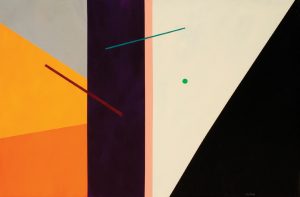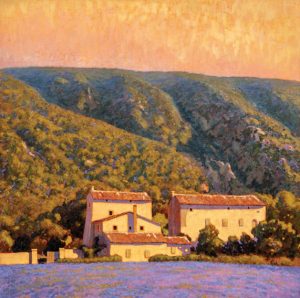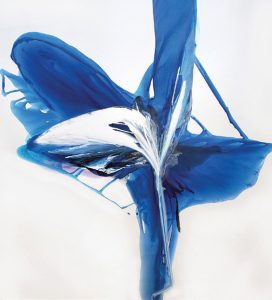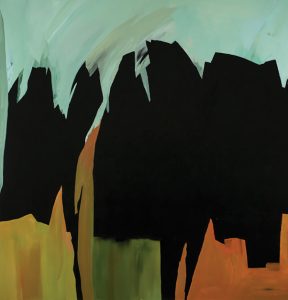
04 Nov Collector’s Notebook: As Worlds Collide
Oftentimes, museum and personal art collections are built around specific genres, be it Abstract, Classical Realism, Cubism, or any number of the other “isms.”
But that’s beginning to change more and more. In a recent exhibit at the Tucson Museum of Art in Arizona, Chief Curator Dr. Julie Sasse applauds the fact that museums and collectors are “finally beginning to celebrate this wonderful diversity [of art] in ways not seen before.”
In the museum’s ongoing exhibit, Art of the American Southwest: Arte del Suroeste de Estado Unidos, a Hyperrealist portrait of a Native American hangs next to an Abstract painting with wild, rich colors that allude to the desert’s biomorphic forms. “Each work responds to the desert in some way,” Sasse says of how the different genres appear side by side in harmony. “If a collector is not simply decorating but truly collecting artworks that are relevant, thought-provoking, emotionally moving, or simply beautiful, they can have a dialogue with each other, whether or not they are in the same movement, genre, or style.”

John Axton, Latin Music | Oil, 40 x 60 inches
Art collector and jewelry designer Ivanka (who goes by her first name only) built a collection in this manner. Born in Czechoslovakia, she grew up in Australia and chose the U.S. as her home. A certified gemologist and respected jeweler, her art collection is eclectic and represents countries from around the world. For many years, museums exhibited her family’s painting of a peasant woman by the great Russian master Ilya Repin. And yet, the Modern pieces in her collection are some of her favorites.
“I like to think of collections as partnerships,” Ivanka says. “They can be whatever one wishes. Appreciation for art is based on how we connect to any given piece. Almost always, it is based on an emotional reaction, whether it’s a painting of a straight line or an Impressionist painting. Perhaps one piece is reminiscent of a time that holds good memories.” She explains that this connection can be a guiding factor when organizing artwork on the wall. “Why can [one work] not relate to other pieces that have [those same] emotions attached to them, no matter the genre?” she asks.

Barry McCuan, Au Dessous Le Petit Luberon | Oil, 48 x 48 inches
Scientific journals support the idea of the emotional effect that art has on the human brain. In a study reported in The Telegraph, professor Semir Zeki from the University College of London revealed that the “pleasure” part of the brain reacts by as much as 10 percent when we look at art, the equivalent of gazing at a loved one.
Another study explains how the brain responds to realistic works versus abstract ones. When viewing a realistic painting, the brain focuses on who, what, when, and how — the same part of the brain responsible for survival, according to a journal from the Proceedings of the National Academy of Sciences. When observing an abstract piece, the brain has no need to react from its natural role; it is freed from the dominance of reality to explore and enjoy the subject.
This joie de vivre has affected collector Ray Harvey. Primarily known for his Western art collection, Harvey has deaccessioned much of it, keeping only his favorites. In his home, paintings that range from Abstract Expressionism to Realism all have their place. In his wine room, Harvey has hung his favorite Robert Henri figurative painting, and nearby is a Cecily Brown abstract work. “It’s so great to see these together,” he says. In another room, an Abstract Expressionist painting by Larry Poons hangs on one wall while a founding member of the Taos Society of Artists, Oscar Berninghaus, hangs in proximity. “You don’t have to buy all modern art to be cool,” he says.

Bette Ridgeway, Pas de Deux | Acrylic, 60 x 50 inches
The trend of integrating modern work into collections based in Realism has led Connie Axton, owner of Ventana Fine Art in Santa Fe, New Mexico, to change how and what she displays. Some of the first artists she represented included her husband John Axton, and painters Doug Dawson and Ramon Kelley — all three are representational artists. “Over the 35 years in my gallery, I have combined contemporary artists, such as Margaret Nes, with the realism of painters like Barry McCuan,” she says. “Then, I added artists who abstracted objects, like Dick Evans, and now I have added more modern artists, including Bette Ridgeway, winner of two Leonardo da Vinci Awards.” Today, her clients come to expect this type of stylistic diversity at the gallery.
Artist John Paul Berry has witnessed his collectors’ preferences change as he has moved from creating academic-based paintings to an abstract variety. Trained at Brigham Young University, Berry’s painting styles encompass professional illustrations to plein air. After some time, he started to see the shapes, values, and harmonies of the landscape in new ways, and he began creating paintings that some might classify as abstract. “I don’t really have a name for it,” he says, “I create one thing, one color, one line, one mark, and that leads to the next one. It’s almost like dancing but without knowing the dance steps in a way that’s terrifying but freeing.”
For collectors who aren’t fully comfortable combining different art genres on the same wall, Scott Burdick and Holly Ogden of Wiseman & Gale Interiors in Scottsdale, Arizona, help collectors make sense of things. “We are paid to tell a story,” Ogden says. “We take peoples’ collections and arrange them so they can enjoy their art.”

Dick Evans, Something Remembered | Acrylic on Canvas, 60 x 60 inches
Oftentimes, rearranging an art display is all that’s necessary. When a collector has purchased a piece of art, then discovers when they get home that it doesn’t seem to fit anywhere, Ogden figures out how to make it work.
“When you love a piece of art that makes your toes curl, there are ways to make it stand out, whether it is a French Impressionist painting or an Op Art piece by Hungarian-born Victor Vasarely,” Burdick says. “You put the two of them in the same room, and the room is better. Put the French Impressionist and the Vasarely next to an African sculpture — those three create a mood.”
Sasse sums up the art of merging a diverse collection: “Abstraction and Realism work together in a home, gallery, or museum because works of art — abstract or realistic — represent different voices, different ideas, and different ways of looking at the world. I’m always drawn to a home that reveals a collector who embraces a wide range of art and cares more about the celebration of a new idea, a remembrance of a special trip, or a moving work of art than how it matches the sofa. Be brave — let your heart and your mind guide your acquisitions.”
Mixing Artistic Genres
- Determine the atmosphere you want to create in a room, and group together paintings and sculptures that help create that specific mood.
- Follow the 80-20 rule by devoting 80 percent of the room’s styling to one genre.
- Tell a story by combining artworks with a theme in one room. For example, group paintings that were collected on a memorable trip or those that represent different artistic styles over the same period.
- Hang favorite works in site-specific locations, and then use complementary works to build the narrative.
- Find “linking” art pieces that might help tie different styles together. These might reference patterns, colors, or moods between different genres.
- Framing is important for cohesion. Consider using frames of a similar style as opposed to switching between ornate and sleek.






No Comments